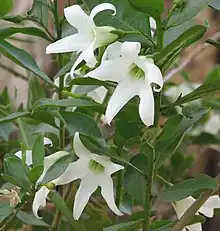| Sticky tailflower | |
|---|---|
 | |
| Scientific classification | |
| Kingdom: | Plantae |
| Clade: | Tracheophytes |
| Clade: | Angiosperms |
| Clade: | Eudicots |
| Clade: | Asterids |
| Order: | Solanales |
| Family: | Solanaceae |
| Genus: | Anthocercis |
| Species: | A. viscosa |
| Binomial name | |
| Anthocercis viscosa | |
Anthocercis viscosa, also known as sticky tailflower, is a species of shrub in the family Solanaceae, native to the south coast of Western Australia. It grows up to 3 metres in height and produces white or cream flowers between May and February (late autumn to late summer) in its native range.[2]
Taxonomy
The species was first formally described by botanist Robert Brown in 1810 in Prodromus Florae Novae Hollandiae. Two subspecies are currently recognised:
- Anthocercis viscosa subsp. caudata Haegi
- Anthocercis viscosa R.Br. subsp. viscosa[1]
References
- 1 2 "Anthocercis viscosa". Australian Plant Name Index (APNI), IBIS database. Centre for Plant Biodiversity Research, Australian Government.
- ↑ "Anthocercis viscosa". FloraBase. Western Australian Government Department of Biodiversity, Conservation and Attractions.
This article is issued from Wikipedia. The text is licensed under Creative Commons - Attribution - Sharealike. Additional terms may apply for the media files.